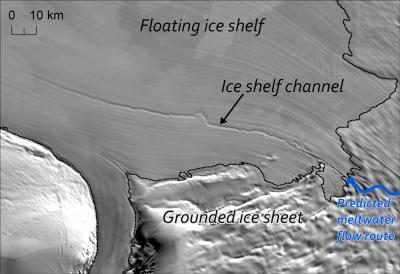Huge ice channels almost as tall as the Eiffel tower have been discovered beneath a floating ice shelf in Antarctica. They are 250 meters high, stretch hundreds of kilometers along the ice shelf, and likely influence the stability of the ice shelf.
The scientists used satellite images and airborne radar measurements to reveal the channels under the ice shelf. The channels can be seen on the surface of the ice shelf, as well as underneath, because the ice floats at a different height depending on its thickness.
The researchers also predicted the path of meltwater flowing under the part of the ice in contact with the land – known as the ice sheet. They discovered that the predicted flow paths lined up with the channels under the ice shelf at the point where the ice starts to float.

The ice shelf channel is clearly visible on the MODIS Mosaic of Antarctica image map; the predicted flow route of water beneath the grounded ice sheet aligns with the initiation of the ice shelf channel. The dashed line marks the point at which the ice starts to float. Credit: MODIS Mosaic of Antarctica (MOA) Image Map / Anne le Brocq.
The match-up indicates that the water flow beneath the grounded ice sheet is responsible for the formation of the channels beneath the floating ice shelf. When the meltwater flowing under the ice sheet enters the ocean beneath the ice shelf, it causes a plume of ocean water to form, which then melts out the vast channels under the ice shelf.
Previously, it was thought that water flowed in a thin layer beneath the ice sheet, but the evidence from this study suggests it flows in a more focused manner much like rivers of water. The way in which water flows beneath the ice sheet strongly influences the speed of ice flow, however, the implications for the future of the ice sheet are yet to be determined.
Dr. Anne Le Brocq from the University of Exeter said, "If we are to understand the behaviour of the ice sheet, and its contribution to changes in sea level, we need to fully understand the role of water at the base of the ice sheet. The information gained from these newly discovered channels will enable us to understand more fully how the water system works and, hence, how the ice sheet will behave in the future."
Channels of this magnitude have been observed before elsewhere, but their formation has been attributed to purely oceanic processes rather than meltwater exiting the grounded ice sheet. Now, with the connection to the meltwater system established, readily obtainable observations from the channels have the potential to shed light on how meltwater flows at the base of an inaccessible kilometer-thick ice sheet.





Comments